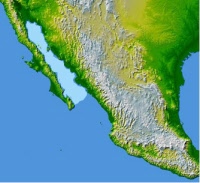Art Custom Framing Gallery Los Cabo San Lucas, San Jose del Cabo, Mexico

 |
Trekking Along The
If you've ever tried to cut a thin slice of Gorgonzola to spread on a fresh piece of French bread, then you have an animated comparison as to how the
But about five million years ago the continual movement along the fault commenced to create the
By the time the
Cataclysmic changes have occurred during the past two million years as well. The peninsula has moved some
The last spectacular evidence that tectonic and seismic activity continues on the peninsula was the 1746 eruption of the Tres Vírgenes volcano, northwest of Santa Rosalía. The San Andreas, Agua Blanca, and Cerro Prieto faults continue to be the source of strong earthquake activity. The peninsula's northwesterly movement is so measurable, an inch or more a year, that NASA sent a laser equipped scientific team to Cabo San Lucas in 1988, and again in 1991, to record a triangulation between Mazatlán, Cabo San Lucas, and
Nothing has changed much during the past five hundred years. The azure waters surrounding the peninsula remain as poignantly blue and glimmering as they have always been; the pristine beaches remain white and soft; the craggy cliffs and bolder strewn encroachments into the Sea of Cortez continue to attest to cataclysmic forces that gave birth to this uniquely picturesque desert‑seascape during its creation; and the sheltered coves and natural bays continue to offer sanctuary and respite to the seafarer searching an escape from the tempestuous winds and seas that infrequently harass these splendid coastal regions now designated as Los Cabos.
What was it like then, before the coming of the sport fisher and the airplane, to trek the twenty odd miles from San José del Cabo to Cabo San Lucas? What a delight it must have been for the Pericú providers to tramp the unspoiled terrain for three or four suns on his rendezvous with finisterra, land's end, where the cold waters of the not so pacific Pacific collide ferociously with the warm and tranquil waters of the Mar de Cortez.
To recapture that atavistic sense of beauty and freedom, you might consider a journey on foot (for at least part of the way) in order to photograph the unequalled beauty of the ruggedness of the
Today, Los Cabos is seemingly only a few steps away from becoming a 21st Century tourist center with modern hotels, instant communication with the real world, a plethora of fine restaurants offering cross cultural cuisine, world class fishing, easy access from the United States and Canada, and a four lane highway from the Los Cabos International Airport to the door step of the hotel, home, or condominium of one's choice.
The highway closely follows the path taken by the first aboriginal explorers who lived so freely and graciously here during Baja's unrecorded history. As you casually stroll or drive the littoral of the lower Baja peninsula you will have an unusual opportunity to record the dissipating morning shadows, the scorching brightness of the
There is harshness and brutality at the cape just as there is hushed quietude during a moon illumined night, serenity following a storm, and lingering sensuality from its ocean breezes. Cabo is many things to many people and everything to a few. Capture these fleeting nuances as you follows the footsteps of that indigenous hunter who traversed the peninsula before you ‑ those many, many years ago.